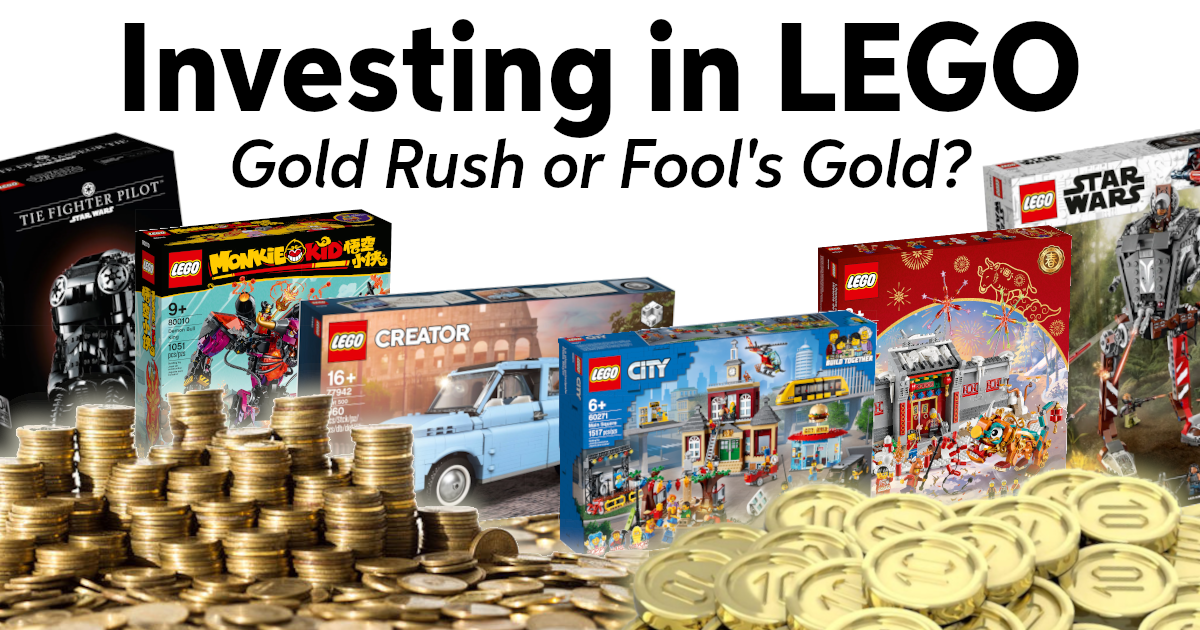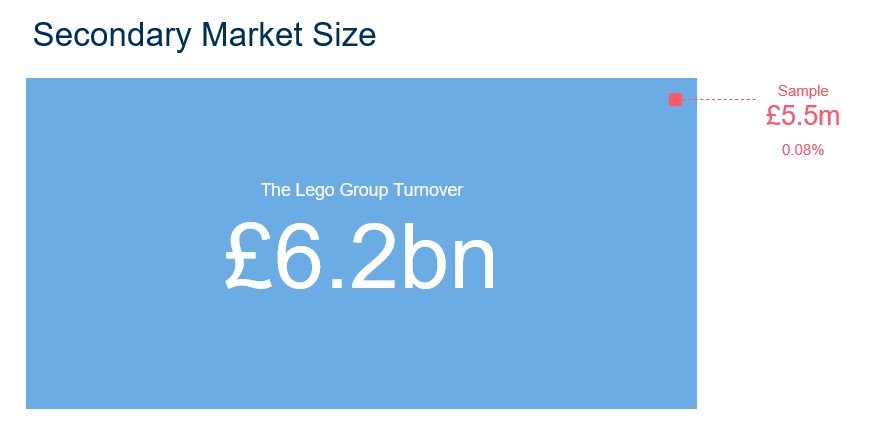We are pleased to present a short series on LEGO investments in which we will attempt to quantitatively answer the eternal question: “Is LEGO a better investment than gold?”

1. Introduction
Stocks, bonds, gold, art… & LEGO?
In December 2021, the British newspaper The Guardian published an article headlined ‘Investing in LEGO could be ‘more lucrative than gold’. It reported on the work of Victoria Dobrynskaya, an associate professor in the HSE Faculty of Economics. The research concluded that the annual return on investing in LEGO was 11% per year (8% in real terms) based on a sample of 2,322 LEGO sets over the period 1987 to 2015.

That’s an impressive return, and according to the research, it’s “faster and better than gold, stocks, bonds, stamps, and wine.” But before you sell your Tesla shares, cash out your stash of gold bars, or throw out (or maybe drink?) your collection of fine vintage wines to reinvest in LEGO, let’s take a closer look at what’s really going on.
2. The "discontinued" Sets monster (2005 to 2021)
Sample size
The sample we chose to analyze consists of every LEGO set with 500 or more pieces that was retired between 2005 and 2021 (sourced from Brickset). We then obtained the average sales price for new sets from BrickLink, which includes all sales over the 6-month period ending in September 2022.
There are some pros and cons to using BrickLink price data. The main downside, anecdotally from watching YouTube videos about investing, is that selling on eBay or Amazon can yield a higher sale price.
It would be interesting to hear from LEGO investors who sell on multiple platforms and could give some indication of sales distributions and any differences in returns. But for now, BrickLink benefits from a very large sample size of sales. It also reports sales volumes, which means we can make some useful estimates of supply and demand that aren’t possible on other platforms.

In total, 911 LEGO sets (with 500 pieces or more) were discontinued between 2005 and 2021. In 2005, only 19 sets were discontinued, and in 2021, 98 sets were discontinued. 85 sets were excluded due to insufficient sales data, bringing the total sample size to 836 sets.
The performance
The following figures are in pounds sterling (sorry!). However, sterling is not all that far from parity with the US dollar and euro, so the comparison should not be too difficult and it is the percentage yield that we will focus on.

Of our sample of 826 sets, 16,200 were sold on BrickLink in 6 months, generating a turnover of £2.7 million. On average, sets sold for 54% more than their original retail price.
That looks pretty good at first glance. An average return of 54% in such a large sample shows consistency in the price increases after retirement. However, 54% represents the total return and does not distinguish between when the sets were purchased. The sale could have been:
-
A 2005 set where a 54% return over 17 years is 'not great'
-
A 2014 set where a 54% return over 8 years is 'not great, not terrible'
-
A 2021 set where a 54% return over 1 year is 'absolutely fantastic'
We will correct for this time aspect and calculate an annual return below.
Size of the secondary market
Even though our sample doesn’t include Amazon sales, eBay sales, or sales of smaller sets, it’s still useful to compare it to the overall market for LEGO products. The LEGO Group had a turnover of 55.2 billion kr in 2021, which equates to 6.2 billion pounds (at the exchange rates of September 2022 when these calculations were performed). The annual market value for our sample is (2.7 million pounds x 2) = 5.5 million pounds, which represents only 0.08% of the LEGO Group’s turnover, effectively a rounding error.

Granted, our sample isn’t complete, but even if we assume it’s four times as big, it would still only represent 0.3%. Furthermore, the total size of the LEGO market is larger than The LEGO Group’s revenue, as it doesn’t take into account the margin made by other retailers selling LEGO products, such as Amazon, Walmart and the rest.
£5.5 million is global sales, and most LEGO investors will be limited to reselling their sets in their own country or region. If the secondary market sales profile matches the sales profile of The LEGO Group, our £5.5 million example would be split as follows:
-
£2.2m (42%) – Europe, Middle East and Africa
-
£2.1m (40%) – America
-
£0.8m (18%) – Asia Pacific

What does this all mean? Compared to the mainstream investments mentioned above (gold, stocks, bonds, etc.), the secondary market is extremely niche. There are no hedge funds looking to diversify into old LEGO sets anytime soon, because it simply isn’t scalable.
I know from online videos on YouTube that there are people who make a full-time living selling LEGO. However, I assume they will be in the minority and most will invest more for the fun of it: making a little extra money to finance their hobby.
3. Return on Investment
Adapt to actual conditions
Return on Investment (ROI) is a relatively simple metric used to compare the performance of different asset classes, measured as an annual percentage increase (or decrease if you’re unlucky). To better align our numbers with the returns LEGO Investors see in practice, I’m going to make two adjustments.
Firstly, it is likely that LEGO Investors are timing their purchase to get a discount and have assumed an average discount of 20% on the RRP obtained from Brickset. Secondly, I have assumed that 15% of the sale price is deducted in the form of platform fees and other miscellaneous costs.
At this stage I am not going to make any adjustments for the time spent or the storage costs. But storage is clearly a big issue and even if there is no additional cost, there is the opportunity cost of not being able to use that space for other activities.
Return on Investment Results
For the 16,200 individual sets (units) sold through BrickLink in the 6 months to September 2022, the average annual return on investment was 11.7%.

These results are exceptionally strong, and it's hard to deliver a consistent 11.7% ROI on a traditional investment without taking risks that most conservative investors would find unacceptable. What's most surprising is that the ROI remained remarkably consistent across all years (remember, that's the year the set was discontinued, not when it was sold).
The breakdown of units sold is also worth highlighting. 41% of sales came from sets that were discontinued in 2020 and 2021, indicating that some investors sold quickly and locked in their returns within 12-24 months of initial purchase. 11.7% also matches the 11% published in Victoria Dobrynskaya’s study (which was undoubtedly more detailed and scientific than mine), so that lends additional validity to the results (phew, I’ll take that!).
Top Performers
The purpose of this article was not to look at individual sets or provide investment tips, but to conduct an unbiased assessment of 'LEGO Investing'. However, given the wealth of information in my spreadsheet, I thought you might find it interesting to look at the Top 20 sets that were retired in 2020 or 2021. Have any recent purchases appeared?

'Lies, damned lies and statistics' (Benjamin Disraeli)
Before we compare the 11.7% return to other mainstream investments, I want to emphasize how easy it is for organizations to manipulate growth figures if they so choose. It all comes down to choosing your starting point. The following example looks at the S&P 500 index between 2000 and 2022.

If I wanted to make the S&P 500's performance look relatively weak, I would pick a starting point just before the 2008 financial crisis and subsequent market collapse, which would yield an ROI of 6.0% per year. However, if it were in my interest to make the S&P 500 look as strong as possible, I would pick a starting point just 18 months later, which would yield 13.4% per year growth over a 13.5 year period. Disraeli was right, because the difference between the two is simply staggering.
This trick is used regularly in the news media, business reporting, and politics. Just keep an eye on it the next time you see a trend chart or growth rate in the news. To eliminate this distortion here, I have chosen September 1, 2004 as my starting point, halfway between the early 2000s recession and the 2008 financial crisis, which gives us a decent 18-year period.
Junk Bond Trader

We will say right away that we do not like this chart. It is not that the information is incorrect or manipulated to show a biased position. It is not, the numbers are correct. We do not like it because it gives LEGO Investing a 'false equivalence'. When we put it together with the other investments, we are essentially saying that they are comparable (because we are comparing them!), but clearly there is virtually no comparison possible.
Not only is the market for retired sets relatively minuscule, but LEGO investments require both time and space, which comes at a cost (the cost of "INVENTORY" in our case: Space, Interest, Risk and Repair).
The others require just the click of a button and your property is stored on a financial institution's server, not in your basement or spare room (unless you have a few gold bars hidden under the floorboards).

Image by Maciejbledowski, via Envato Elements
We also wouldn't want anyone who isn't familiar with LEGO Investing to look at this and think that we're promoting it over the other investments. We certainly don't want that. That said, we still think this discussion has value. It's given us some good insight into how LEGO Investors perform, and we need to understand a little bit about how big the market is.
For us personally, the numbers make us feel a little less guilty about spending money on LEGO. If you take care of it, your money is still sitting on your shelf, unlike a dinner out, streaming subscription or vacation where once the money is spent, it stays spent and you’re left with nothing but memories (and sometimes a hangover).
Has this exercise convinced us to become a LEGO investor? Yes, because 11.7% is a very good return, but the time required, the storage implications and the hassle of dealing with returns and demanding clients may not be for you.
Next time
We really enjoyed putting this together and if you're still reading, we can only congratulate you on making it this far and hope you found something interesting.
But this analysis is not over yet, we need a part 2. Despite the large sample size of over 800 sets, there is still an underlying bias in the sample that simply cannot be removed.
The sample may be excellent at measuring returns on sets that have sold, but unfortunately it doesn’t pay any attention to the sets that don’t sell. For example, despite a healthy 9.5% return on sets retiring in 2021, two-thirds of those sets (67 out of 96) are currently selling at a loss. And dig a little deeper and it’s clear that there’s a major oversupply problem.

Image by rawf8, via Envato Elements
In Part 2, we’ll put the returns in this article to the test and attempt to better understand the vulnerability that isn’t immediately apparent in the analysis provided here. We’ll also introduce “Inventory Turnover,” a metric we think both LEGO investors and BrickLink parts sellers will find useful, and show how it can be easily calculated using data from BrickLink.
So don't drink that 1981 vintage Sauvignon Blanc just yet – LEGO might not be the investment it seems…















































